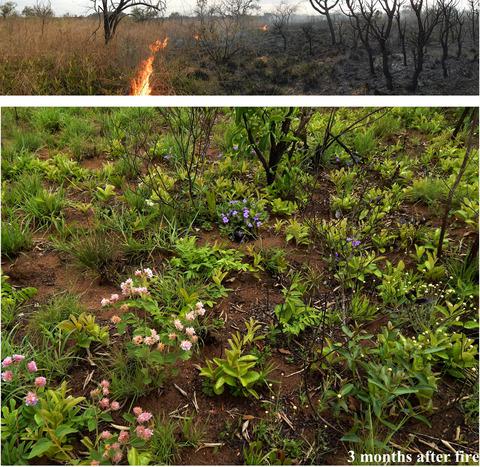Our official English website, www.x-mol.net, welcomes your feedback! (Note: you will need to create a separate account there.)
The diversity of post‐fire regeneration strategies in the cerrado ground layer
Journal of Ecology ( IF 5.5 ) Pub Date : 2020-06-24 , DOI: 10.1111/1365-2745.13456 Natashi A. L. Pilon 1 , Mário G. B. Cava 2 , William A. Hoffmann 3 , Rodolfo C. R. Abreu 3, 4 , Alessandra Fidelis 5 , Giselda Durigan 1, 6
中文翻译:

塞拉多地面层火后再生策略的多样性
更新日期:2020-06-24
Journal of Ecology ( IF 5.5 ) Pub Date : 2020-06-24 , DOI: 10.1111/1365-2745.13456 Natashi A. L. Pilon 1 , Mário G. B. Cava 2 , William A. Hoffmann 3 , Rodolfo C. R. Abreu 3, 4 , Alessandra Fidelis 5 , Giselda Durigan 1, 6
Affiliation

|
- Disentangling species strategies that confer resilience to natural disturbances is key to conserving and restoring savanna ecosystems. Fire is a recurrent disturbance in savannas, and savanna vegetation is highly adapted to and often dependent on fire. However, although the woody component of tropical savannas is well studied, we still do not understand how ground‐layer plant communities respond to fire, limiting conservation and management actions.
- We investigated the effects of prescribed fire on community structure and composition, and evaluated which traits are involved in plant community regeneration after fire in the cerrado ground layer. We assessed traits related to species persistence and colonization capacity after fire, including resprouter type, underground structure, fire‐induced flowering, regeneration strategy and growth form. We searched for functional groups related to response to fire, to shed light on the main strategies of post‐fire recovery among species in the ground layer.
- Fire changed ground‐layer community structure and composition in the short term, leading to greater plant species richness, population densities and increasing bare soil, compared with unburned communities. Eight months after fire, species abundance did not differ from pre‐disturbance values for 86% of the species, demonstrating the resilience of this layer to fire. Only one ruderal species was disadvantaged by fire and 13% of the species benefited. Rapid recovery of soil cover by native vegetation in burned areas was driven by species with high capacity to resprout and spread vegetatively. Recovery of the savanna ground‐layer community, as a whole, resulted from a combination of different species traits. We summarized these traits into five large groups, encompassing key strategies involved in ground‐layer regeneration after fire.
- Synthesis. Fire dramatically changes the ground layer of savanna vegetation in the short term, but the system is highly resilient, quickly recovering the pre‐fire state. Recovery involves different strategies, which we categorized into five functional groups of plant species: grasses, seeders, bloomers, undergrounders and resprouters. Knowledge of these diverse strategies should be used as a tool to assess conservation and restoration status of fire‐resilient ecosystems in the cerrado.
中文翻译:

塞拉多地面层火后再生策略的多样性
- 赋予物种抵御自然干扰能力的各种策略,是保护和恢复热带稀树草原生态系统的关键。火灾是热带稀树草原的一个经常性扰动,热带稀树草原的植被高度适应并经常依赖于火灾。但是,尽管对热带稀树草原的木质部分进行了充分的研究,但我们仍然不了解地层植物群落如何应对火灾,从而限制了保护和管理行动。
- 我们调查了明火对群落结构和组成的影响,并评估了塞拉多地面层火灾后植物群落再生涉及哪些性状。我们评估了火灾后物种持久性和定居能力的相关特征,包括生殖器类型,地下结构,火灾诱导的开花,更新策略和生长形式。我们搜索了与火灾响应相关的功能组,以阐明地层物种之间火灾后恢复的主要策略。
- 与未燃烧的社区相比,火灾在短期内改变了地层社区的结构和组成,从而导致植物物种的丰富度,种群密度和裸土增加。火灾后八个月,物种丰富度与干扰前的值没有变化,占该物种的86%,这表明该层对火灾的恢复能力。只有一种属物种在火灾中处于不利地位,其中13%的物种受益。具有高萌芽和无性繁殖能力的物种推动着燃烧地区原生植被对土壤覆盖的快速恢复。总体而言,热带稀树草原底层群落的恢复是由于不同物种特征的组合所致。我们将这些特征归纳为五个大类,包括火灾后地面再生的关键策略。
- 综合。火灾在短期内会显着改变稀树草原植被的地层,但系统具有很高的弹性,可迅速恢复火灾前的状态。恢复涉及不同的策略,我们将其分类为植物的五个功能组:草,播种机,bloom草,地下和繁殖者。应将对这些不同策略的了解用作评估塞拉多抗火生态系统的保护和恢复状况的工具。


























 京公网安备 11010802027423号
京公网安备 11010802027423号